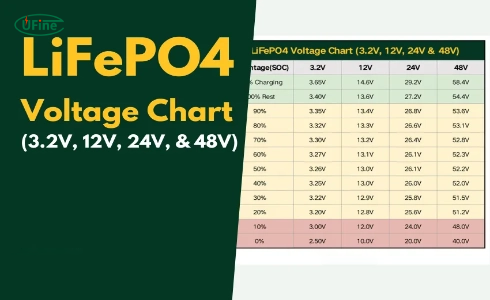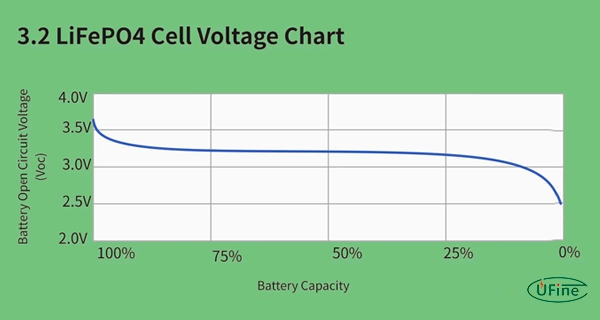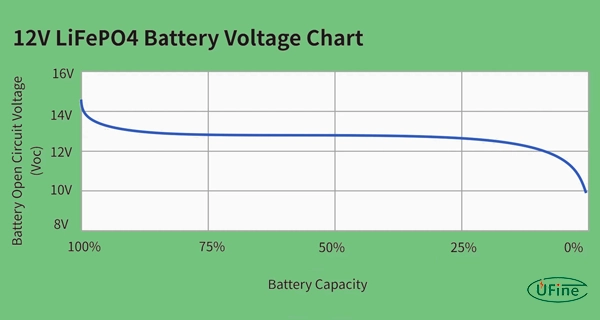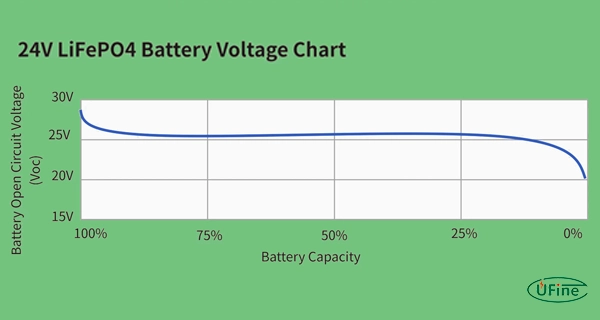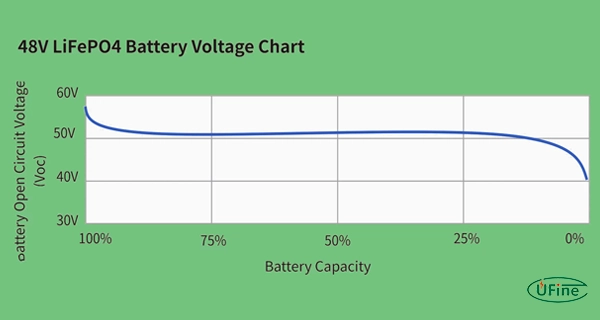LiFePO4 batteries have gained significant popularity in recent years due to their superior performance and safety features compared to traditional lead-acid batteries. As a savvy consumer or industry professional, understanding the voltage characteristics of LiFePO4 batteries is crucial for their efficient and safe operation. In this comprehensive guide, we will delve into the intricacies of LiFePO4 battery voltage and provide you with an ultimate reference chart. So, let’s dive in!
Part 1. What is LiFePO4 battery voltage?
LiFePO4, which stands for Lithium Iron Phosphate, is a type of lithium-ion battery chemistry known for its stability, high energy density, and long cycle life. The voltage of a LiFePO4 battery refers to the electrical potential difference between its positive and negative terminals. Let’s explore these voltage levels in detail:
- Nominal Voltage
The nominal voltage of a LiFePO4 battery is typically 3.2 volts per cell. This value represents the average operating voltage during normal conditions. For example, a 12-volt LiFePO4 battery pack consists of four individual cells, each with a nominal voltage of 3.2 volts. Understanding the nominal voltage helps select the appropriate battery pack for your application.
- Fully Charged Voltage
When a LiFePO4 battery reaches full charge, its voltage typically reaches around 3.6 to 3.7 volts per cell. Remember that exceeding this voltage can lead to overcharging and potentially damage the battery. A reliable charger with built-in safeguards is essential to prevent overcharging and maintain the battery’s longevity.
- Storage Voltage
LiFePO4 batteries have an optimal storage voltage range, typically between 3.2 and 3.3 volts per cell. Storing the battery within this voltage range ensures its longevity and minimizes self-discharge. Suppose you plan to store your LiFePO4 battery for an extended period. In that case, monitoring its voltage regularly and recharging it if it falls below the recommended storage voltage is crucial.
- Discharge Voltage
The minimum discharge voltage of a LiFePO4 battery is typically around 2.5 to 2.8 volts per cell. Discharging the battery below this voltage threshold can lead to irreversible damage and significantly reduce its cycle life. To protect your LiFePO4 battery and maximize its lifespan, use a battery management system (BMS) to prevent over-discharging.
- Deep Discharge
Deep discharging refers to discharging a LiFePO4 battery to its lowest possible voltage level. While LiFePO4 batteries are more tolerant of deep discharges than other lithium-ion chemistries, it is still essential to avoid deep discharging whenever possible. Deep discharges can lead to capacity loss and negatively impact the battery’s overall performance.
Part 2. LiFePO4 voltage chart: 3.2V, 12V, 24V, 48V
Understanding the relationship between the state of charge (SoC) and voltage levels is crucial for effectively managing LiFePO4 batteries. Here is a voltage chart depicting the SoC range for different LiFePO4 battery pack configurations:
|
State of Charge |
3.2V Configuration |
12V Configuration |
24V Configuration |
48V Configuration |
|
0% Charging |
2.5V – 3.0V |
10.0V – 12.0V |
20.0V – 24.0V |
40.0V – 48.0V |
|
10% Charging |
3.0V – 3.2V |
12.0V – 12.6V |
24.0V – 25.2V |
48.0V – 50.4V |
|
20% Charging |
3.2V – 3.3V |
12.6V – 13.2V |
25.2V – 26.4V |
50.4V – 52.8V |
|
30% Charging |
3.3V – 3.4V |
13.2V – 13.8V |
26.4V – 27.6V |
52.8V – 55.2V |
|
40% Charging |
3.4V – 3.5V |
13.8V – 14.4V |
27.6V – 28.8V |
55.2V – 57.6V |
|
50% Charging |
3.5V – 3.6V |
14.4V – 15.0V |
28.8V – 30.0V |
57.6V – 60.0V |
|
60% Charging |
3.6V – 3.7V |
15.0V – 15.6V |
30.0V – 31.2V |
60.0V – 62.4V |
|
70% Charging |
3.7V – 3.8V |
15.6V – 16.2V |
31.2V – 32.4V |
62.4V – 64.8V |
|
80% Charging |
3.8V – 3.9V |
16.2V – 16.8V |
32.4V – 33.6V |
64.8V – 67.2V |
|
90% Charging |
3.9V – 4.0V |
16.8V – 17.4V |
33.6V – 34.8V |
67.2V – 69.6V |
|
100% Charging |
4.0V – 4.2V |
17.4V – 18.0V |
34.8V – 36.0V |
69.6V – 72.0V |
|
100% Rest |
3.2V – 3.3V |
12.6V – 13.2V |
25.2V – 26.4V |
50.4V – 52.8V |
This voltage chart overviews the voltage ranges corresponding to different charge states in LiFePO4 battery pack configurations. However, referring to the manufacturer’s specifications for precise voltage values and tolerances is essential.
Let’s explore the different configurations on the voltage charging curves. For the 3.2V configuration, the charging curve provides valuable information about the battery’s state of charge, as shown in the accompanying voltage chart.
Let’s look at the 12V configuration and its corresponding charging curve. The voltage chart illustrates the relationship between voltage levels and the state of charge, offering insights into the charging process.
We also have the 24V configuration, which has a unique charging curve. By examining the voltage chart, we can observe how the battery’s voltage changes through different charge levels.
Lastly, let’s delve into the charging curve of the 48V configuration. The voltage chart presents an overview of the voltage range associated with various states of charge, allowing us to grasp the battery’s charging behavior.
Part 3. LiFePO4 battery charging parameters chart
Users must consider specific charging parameters for properly charging and maintaining LiFePO4 batteries. Here are the key characteristics along with their corresponding values for the 3.2V, 12V, 24V, and 48V configurations:
|
Characteristics |
3.2V |
12V |
24V |
48V |
|
Charging Voltage |
3.6V |
14.4V |
28.8V |
57.6V |
|
Float Voltage |
3.3V |
13.2V |
26.4V |
52.8V |
|
Maximum Voltage |
3.9V |
15.6V |
31.2V |
62.4V |
|
Minimum Voltage |
2.5V |
10.0V |
20.0V |
40.0V |
|
Nominal Voltage |
3.2V |
12.0V |
24.0V |
48.0V |
These charging parameters provide guidelines for the appropriate voltage levels during charging, float charging, and the safe operating range for LiFePO4 batteries in various configurations.
Part 4. LiFePO4 bulk, float, and equalize voltages
- Bulk Voltage: This is the initial stage of charging, during which the LiFePO4 battery is charged at a higher voltage to quickly replenish its energy. It’s like boosting the battery to reach its desired charge level efficiently.
- Float Voltage: Once the LiFePO4 battery reaches its desired charge level, it switches to float charging. In this stage, the battery is charged at a lower voltage to maintain its charge and prevent overcharging. It’s like providing a gentle trickle of power to keep the battery stable.
- Equalize Voltage: Unlike some other battery chemistries, LiFePO4 batteries do not require equalization charging. People use equalization charging to balance the charge levels among individual cells, particularly batteries.
Different types of LiFePO4 batteries have specific voltage requirements for bulk and float charging. Here are the voltage values for the 3.2V, 12V, 24V, and 48V configurations:
|
Types |
3.2V |
12V |
24V |
48V |
|
Bulk |
3.6V |
14.4V |
28.8V |
57.6V |
|
Float |
3.3V |
13.2V |
26.4V |
52.8V |
LiFePO4 batteries typically use bulk charging to charge the battery to a specific voltage level rapidly. Once the battery reaches the desired voltage, it transitions to float charging, which provides a lower voltage to maintain its charge without overcharging. Unlike other battery chemistries, LiFePO4 batteries do not require equalization charging, as they have a relatively stable voltage profile and do not develop significant cell imbalances.
Part 5. Factors influencing LiFePO4 voltage
Several factors can influence the voltage characteristics of LiFePO4 batteries. Here are some key factors to consider:
- Temperature
Temperature has a significant impact on LiFePO4 battery voltage. Extreme high and low temperatures can affect the battery’s capacity, internal resistance, and voltage readings. Operating and charging LiFePO4 batteries within the recommended temperature range is crucial for optimal performance.
- State of Charge (SOC)
The state of charge refers to the battery’s remaining capacity. LiFePO4 battery voltage varies with the state of charge, allowing users to estimate the battery’s energy level. Monitoring the voltage can provide a rough indication of the battery’s SOC, enabling better management of power resources.
- Load Current
The load current, or the current drawn from the battery during discharge, affects the voltage. Higher load currents can cause voltage drops due to internal resistance. It is essential to consider the load current and its impact on the battery’s voltage when designing systems or selecting LiFePO4 batteries for specific applications.
- Battery Age and Cycle Life
Their voltage characteristics may change as LiFePO4 batteries age and go through charge-discharge cycles. Capacity loss and increased internal resistance can lead to voltage deviations. Regular monitoring of the battery’s voltage and capacity can help assess its health and plan for replacements or maintenance.
Part 6. FAQs
-
What voltage should I charge my LiFePO4 battery?
You should typically charge your LiFePO4 battery to around 3.3 to 3.6 volts per cell for optimal performance and longevity. -
Can you charge a LiFePO4 battery from 13.8 V?
No, charging a LiFePO4 battery directly from 13.8 volts is not advisable as it can lead to overcharging and potential damage to the battery. -
Should I charge LiFePO4 to 100%?
Charging LiFePO4 batteries to around 90% rather than 100% is generally recommended. Implementing this approach can extend the battery’s lifespan and prevent stress on the cells. -
What is the best way to charge a LiFePO4 battery?
The best way to charge a LiFePO4 battery is to use a charger specifically designed for LiFePO4 batteries and follow a CC-CV (Constant Current-Constant Voltage) charging profile. This method ensures a safe and efficient charging process, maximizing battery performance and lifespan.
Related Tags:
More Articles

Comprehensive Guide to Choosing the Right Cart Battery
Choosing the right cart battery ensures optimal performance and longevity. This guide covers cart battery types and helps you make an informed choice.
The Ultimate Guide to 18650 Button Top Battery
18650 button top batteries are popular for their high energy density and reliability. This guide covers their key features, usage, and maintenance tips.
The Power of Slim: Unveiling the Potential of Flat Lithium Ion Battery
Flat lithium-ion batteries power devices from phones to vehicles. This article explores their design, benefits, types, applications, charging, and safety.
The Comprehensive Guide to Battery Balancing and Battery Balancer
Battery balancing and balancers optimize performance, longevity, and safety. This guide covers techniques and tips for choosing the right balancer.
10 Key Facts About Drone Battery for 2024
Uncover crucial insights with "10 Key Facts About Drone Battery for 2024." Learn the latest trends and essential details on drone batteries.
